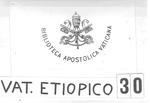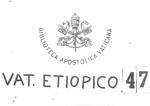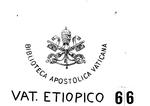There are 22 entities matching your text query for "ደምከ" with the parameters shown at the right. (searched: ደምከ)
Search time: 0.575 seconds.Bǝḥerāwi Kǝllǝlāwi Mangǝśti Tǝgrāy, Ḥarennat Gabazayti Qǝddǝst Māryām, MHG-010

abSignatures
MHG-010Short Description
This parchment codex is composed of...ቅንዋተ፡ እደዊከ፡ ወአአጋረከ። ኦወ ወፍ፡ በቅዱስ፡ ወበክቡር፡ ደምከ። ኦወል፡ ወፍባዕ፡ በገበዛቲከ፡ ወበሞትከ። ኦወ፡ ወ...
Book of Samuel 2 = (Ethiopic) Book of Kings 2
CAe 2698Clavis Aethiopica, an ongoing repertory of all known Ethiopic Textual Units. Use this to refer univocally to a specific text in your publications. Please note that this shares only the numeric part with the Textual Unit Record Identifier.
t:lወይቤሎ ፡ ዳዊት ፡ ደምከ ፡ ላዕለ ፡ ርእስከ ፡ ለይኩን ፡ እስመ ፡ አፉከ ፡ ነበበ ፡ ወትቤ...
incipitabSignatures
BML Acq. e doni 810, Marrassini ms. 10Short Description
This parchment codex is composed of...ማዲነ፡ እለ፡ አዕረፉ፡ እለ፡ በልዑ፡ ሥጋከ፡ ቅዱሰ፡ ወሰትዩ፡ ደምከ፡ ክቡር፤ አንብሮሙ፡ በየማን...
... እለ፡ አዕረፉ፡ እበ፡ በልዑ፡ ሥጋከ፡ ቅዱስ፡ ወሰትደ፡ ደምከ፡ ክቡር፤፡ አንብሮሙ፡ በየማንከ፡ ምስለ፡ አብ...
...ወበሞተከ፡ ተቤዘወት። እስመ፡ በእንተ፡ ሰብእ፡ ከዓውከ፡ ደምከ፡ ከም፡ ታድኅኖ፡ ማዳም፡ ወ...
abSignatures
BML Or. 403, Marrassini ms. 11, BML-011Short Description
This parchment codex is composed of... እገሪከ፨ መሐልኩ፡ ለከ፡ በቅዱስ፡ ሥጋከ፡ ወበቅዱስ፡ ደምከ፡ መሐልኩ፡ ለከ፡ በሕማማቲከ፡ ወበሞትከ፡ ...
... እገሪከ፨ መሐልኩ፡ ለከ፡ በቅዱስ፡ ሥጋከ፡ ወበቅዱስ፡ ደምከ፡ መሐልኩ፡ ለከ፡ በሕማማቲከ፡ ወበሞትከ፡ ...
quoteSignatures
MQM-004Short Description
This parchment codex is composed of...፡ ቦቱ፡ በኑ፡ ደምከ፡ ተከዕወ፡ ለከንቱ።
List of related persons
- scribe: Za-Māryām, Takla Māryām
- owner: The colophon mentions that the Ms. was bought by the church ʾAbuna Gabra Manfas Qǝddus of ʿOna Maʿḍo. Different names are written in the supplication formulas throughout the Ms.: Ker ʾƎgziʾ (e.g., , 4vb, 7rc); Walda Krǝstos (e.g., , 32ra, 34rb); ʾƎsṭifānos (e.g., , 32ra, 34rb); Gädä Māryām (e.g., ). Ker ʾƎgziʾ and Gädä Māryām are also mentioned in Ms. MQM-002.
- scribe: Za-Māryām, Takla Māryām
- owner: According to the colophon the Ms. belongs to the church Gabra Manfas Qǝddus of ʿOna Maʿḍo
Gondar, Private Collection of Ato Hayle Bayyana, Gondar private collection of Ato Hayle Bayyana
t:abSignatures
Gondar private collection of Ato Hayle BayyanaShort Description
This is composed of leaves. It has 1 main content units in 1 codicological unit. The description does not include a collation of the quires.... እደዊከ ወእገሪከ ወይከውን ደምከ ከመ ደ
... መላእክት ኀበ ዘተክዕወ ደምከ። ወአነ እመጽእ ምስለ ሊቅየ ሚካኤል ወእነሥእ ለነፍስከ። ...
incipitSignatures
MY-013Short Description
This parchment codex is composed ofHymn to St Victor
CAe 2958Clavis Aethiopica, an ongoing repertory of all known Ethiopic Textual Units. Use this to refer univocally to a specific text in your publications. Please note that this shares only the numeric part with the Textual Unit Record Identifier.
t:lደምከ፡ ፍዳ፡ ተክዕወ፨
Lalibela, Beta Gabrǝʾel, EMML no. 6952Lalibela, Beta Gabrǝʾel, EMML no. 6952
Link to images
abSignatures
EMML no. 6952Short Description
This parchment codex is composed ofLalibela, Beta Gabrǝʾel, EMML no. 6952Lalibela, Beta Gabrǝʾel, EMML no. 6952
Link to images
abSignatures
EMML no. 6952Short Description
This parchment codex is composed ofMalkǝʾ-hymn to St Victor
CAe 2785Clavis Aethiopica, an ongoing repertory of all known Ethiopic Textual Units. Use this to refer univocally to a specific text in your publications. Please note that this shares only the numeric part with the Textual Unit Record Identifier.
t:lAbstract
Tarafa malkǝʾ toደምከ፡ ፍዳ፡ ተክዕወ፨
Malkǝʾa masqal
CAe 2842Clavis Aethiopica, an ongoing repertory of all known Ethiopic Textual Units. Use this to refer univocally to a specific text in your publications. Please note that this shares only the numeric part with the Textual Unit Record Identifier.
t:lAbstract
According to , this malkǝʾ was possibly written by an otherwise unknown Ləssāna Maṣḥaf. Its fifteenth stanza circulates on its own as a magic text (see, for example, ).እንበለ፡ ደምከ፡ ወመስቀልከ፡ ቡሩክ፨
explicitSignatures
MNC-016, MS 117, Inventory number: 50513Short Description
This parchment codex is composed of... እለ፡ በላዕነ፡ ሥጋከ፡ ወእለ፡ ሰተይነ፡ ደምከ፡ ይኵንነ፡ ለስርየተ፡ ኃጢአት፡ ወለሕይወት፡ ዘለዓለም፡ በ...
t:abSignatures
BnF Éthiopien 616, Griaule 308Short Description
This parchment codex is composed of... አግብርተ፡ ቤተከ። ወይመትሩ፡ እደዊከ፡ ወእገሪከ፡ ወይከውን፡ ደምከ፡ ከመ፡ ደ
... አክናፈ፡ መላእክት፡ ኀበ፡ ዘተክዕወ፡ ደምከ። ወአነ፡ እመጽእ፡ ምስለ፡ ሊቅየ፡ ሚካኤል፡ ወእነሥእ፡ ...
incipitSignatures
BnF Éthiopien d'Abbadie 102Short Description
This parchment codex is composed of... ዘሥጋዌሁ፡ መስቀል፨ በእንተ፡ ደምከ፡ ክቡር፡ ቤዛ፡ ኀጣን፡ እምኃጕል፨ ...
abSignatures
Tweed MS 5Short Description
This parchment scroll is composed of leaves. It has 1 main content units in 1 codicological unit. The description does not include a collation of the quires....ን፡ ውዑይ፡ ወአኮ፡ በማይ። ተማኅ፡ በእሳተ፡ ሥጋከ፡ ወድዋዓ፡ ደምከ፡ ማኅያዊ። ዘወሀብኮሙ፡ ለዓርድዕት፡ በምሴተ፡ ሐሙስ፡ ፋሲ...
abSignatures
RNB Ef. n.s. 5, IV Efiopsk. 5, Turaev cat. I.13Short Description
This parchment codex is composed of...ግዚኦ᎓ ለገብረ᎓ ሐዋር ያት ሤጠ᎓ ደምከ᎓ ወምስለ᎓ ኅሩያኒከ᎓ ይርአይ᎓ ስብሐተ᎓ መንግሥትከ᎓ ወነ...
qSignatures
Aeth. 13, 9,Short Description
This leather codex is composed of...ከኒ፡ ከመ፡ ናእኩትከ፡ ወንደመር፡ ለቅዱስ፡ ሥጋከ፡ ወለቅዱስ፡ ደምከ።
explicitSignatures
Aeth. 30Short Description
This parchment codex is composed of... ዘተጠብሐ፡ ምህላነ፡ ረሲ፡ ንፁሐ፡ በእንተ፡ ደምከ። በዲበ፡ ዕፅ...
... ምህላነ፡ ረሲ፡ ህልወ። በዝ፡ ስጋከ፡ ወብዝ፡ ደምከ፡ ተማሕጸነ፡ እሊአከ፡ ምህላነ፡ ደይ፡ በሕፅንከ። ፫በል፡ ...
sicSignatures
Aeth. 39Short Description
This leather codex is composed ofexplicitSignatures
Aeth. 47Short Description
This parchment codex is composed of...፡ ለሀጥኣን፡ ዘተጠብሃ፡ ምህላነ፡ ረሲ፡ ንፁሐ። ሃ፡ በእንተ፡ ደምከ፡ በዲበ፡ ዕፅ፡ ዘተክዕወ፡ ምህላነ፡ ረሲ፡ ህልወ። በዝ፡ ...
...ዕፅ፡ ዘተክዕወ፡ ምህላነ፡ ረሲ፡ ህልወ። በዝ፡ ሥጋከ፡ ወበዝ፡ ደምከ፡ ተማኅፀነ፡ እሊአከ፡ ምህላነ፡ ደይ፡ ...
qSignatures
Aeth. 66Short Description
This paper codex is composed of... እለ፡ በልዑ፡ ሥጋከ፡ ወሰትዩ፡ ደምከ፡ ደምር፡...








